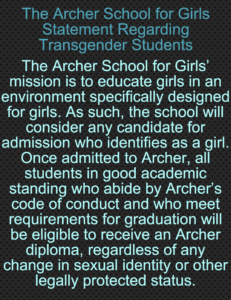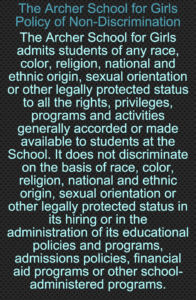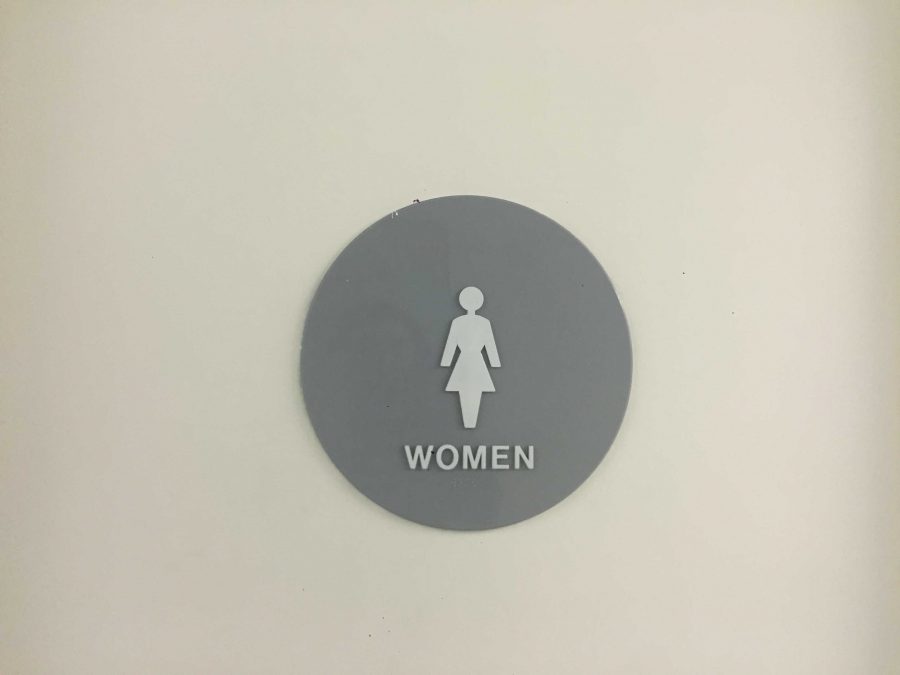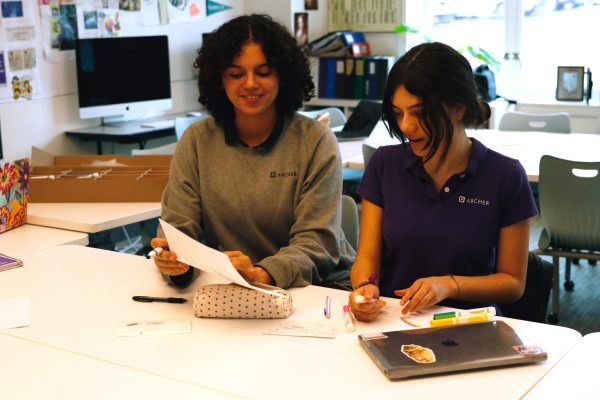Redefining ‘Girl’: Archer, Seattle Girls’ School address transgender students
This traditional symbol for women adorns restrooms across the country, including here at Archer. The Archer School for Girls and Seattle Girls’ School recently addressed the issue of transgender students. Both schools consider admission for students in good academic standing who identify as females. Photographer: Logan Connors ’17
As celebrities such as Caitlyn Jenner and Laverne Cox speak out about transgender inclusiveness, this cultural conversation creates a dilemma for single-sex schools: How should all-girls schools deal with transgender applicants and students who transition after applying?
Addressing lesbian, gay, bisexual and transgender (LGBT) topics has become increasingly important, especially in schools. Recent studies have found the effects school environments can have on students’ well-being and academics. A 2012 study by New York University published in The Journal of School Violence shows that LGBT students are more likely to experience bullying, which can lead to a decrease in school attendance.
The Journal of Adolescent Health’s 2011 meta-analysis showed that suicide rates for those identifying as LGBT are about three times higher in comparison to heterosexual youth. In a more positive and supporting environment, there was a lower probability of negative outcomes.
Studies like these express the urgency for schools to start addressing how to help LGBT students feel safe and supported on campus, and single-sex schools have to decide how to define “boy” and “girl.”
The Oracle sat down with Head of School Elizabeth English to discuss Archer’s new statement about transgender students. Additionally, Head of School Rafael del Castillo of Seattle Girls’ School shared his school’s similarly open environment for diversity in a phone interview.
Both The Archer School for Girls and Seattle Girls’ School have now crafted inclusive statements about transgender students, hoping to reflect their schools’ accepting environments.
The Archer School for Girls’ Statement
Archer has a policy of non-discrimination and a more specific statement regarding transgender students.
English said that Archer’s senior administrative team had previously been debating the topic, but in the last six months, discussions had gotten more intensive.
English shared that Wellesley College‘s transgender discussion influenced her conversation with Archer administration.
The New York Times published Ruth Padawer’s article “When Women Become Men at Wellesley,” which discusses the questions that the college encounters when students transition to male on the single-sex campus.
“Exactly how Wellesley will resolve the trans question is still unclear,” Padawer wrote in her piece. “Trans students say that aside from making sure every academic building on campus has a unisex bathroom, Wellesley has not addressed what gender fluidity means for Wellesley’s identity.”
 “That [article] was,” English said, “a turning point for the conversation because it’s very well-written and it addresses the complexities [that] single-gender institutions face when thinking about gender in a more fluid and expansive way. That spurred conversation among the senior administrative team and among my colleagues at girls’ schools, whom I’ve been talking with as well.”
“That [article] was,” English said, “a turning point for the conversation because it’s very well-written and it addresses the complexities [that] single-gender institutions face when thinking about gender in a more fluid and expansive way. That spurred conversation among the senior administrative team and among my colleagues at girls’ schools, whom I’ve been talking with as well.”
English said that the issue involves many factors, including religion, secularism, traditions and values.
Archer did not feel pressure, although English said that the heightened consciousness about gender led them to have the conversation.
“We try to be as inclusive as possible,” English said. “If we had a student in our midst who underwent a change in gender identity we would support that student.”
Seattle Girls’ School’s Statement
In a phone interview, Castillo shared Seattle Girls’ School’s policy and the process through which the school came to this decision.
“We spent a little bit of time talking about how we would admit students who are transgender. Seattle Girls’ School admits students who identify as female regardless of their biological sex,” Castillo said. “I think it just became really current and relevant, so we just started the conversation. I would say that, for us, it was a fairly easy conversation to conclude — we definitely were going to air on the side of inclusion because that’s the way we’ve been founded, really.”
Castillo believes that having more perspectives in the school benefits not only the students but also the whole community.
“It’s a natural extension of what we believe. We believe that the more diverse the community, the more perspectives we can bring into the community, the better the learning is,” Castillo said.
Castillo believes it is important that people become educated on “the changing perspectives on gender.”
“I’ve always had a pretty inclusive journey in my life, and it’s important that we as adults understand how young people are viewing gender today and that we stay adaptable to that changing view,” Castillo said. “We had several graduates already transition. It’s a very open and inclusive space here, so I would say within the school there wasn’t a lot of pressure one way or another– it just seemed like a natural evolution.”
Castillo sees learning as an important part of being an educator, so he has traveled to places such as the Bay Area in California and the East Coast to expand his knowledge.
“For girls schools, where gender is part of why we exist…it’s a complicated question that requires that we all get informed,” Castillo said. “The more we know about each other’s perspectives, the better the conversation is.”
A Welcoming Environment
As the discussion on gender becomes more prevalent, especially in single-sex schools, The Archer School for Girls and Seattle Girls’ School are attempting to be accepting environments following what their mission statements stand for.
According to both English and Castillo, the schools have welcoming environments for all, and there are equal opportunities for all students who attend.
“A child is a child, and a student is a student,” English said. “I can’t imagine turning my back on any student here.”

Logan Connors joined the Oracle writing staff in 2015. She is on the varsity equestrian team and has been riding for 12 years. She is a member of the Best...








